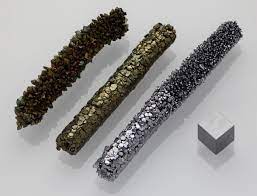Identity.
Vanadium is a gray metal with a body-centered cubic crystal system. It is a member of the first transition series. Because of its high melting point, it is referred to as a refractory metal (Baroch 2006). When highly pure, it is a bright white metal that is soft and ductile.
Atomic Structure:
The nucleus consists of 23 protons (red) and 28 neutrons (blue). 23 electrons (green) bind to the nucleus, successively occupying available electron shells (rings).
History.
Vanadium boasts a unique history marked by both early discovery and mistaken identity. While credited to Swedish chemist Nils Gabriel Sefström in 1830, vanadium actually has an earlier claim to fame. In 1801, Spanish mineralogist Andrés Manuel del Rio extracted the element from a mineral sample. However, believing it to be an impure form of chromium, he eventually abandoned his findings.
Years later, Sefström stumbled upon the same element while analyzing iron ore. Recognizing its distinct properties, he named it after the Norse goddess Vanadis, alluding to the beautiful colors its compounds displayed. This "rediscovery" cemented vanadium's place in the scientific world, paving the way for its diverse applications in steel alloys, energy storage, and even medicine.
Usage.
Vanadium can be used to make steel alloys, for use in space vehicles, nuclear reactors and aircraft carriers, etc. Vanadium steel alloys' strength means that they are perfectly suited to the creation of tools, axles, piston rods and as girders in construction. Vanadium can be utilised in ceramics as a pigment.
-
Steel Alloys:Vanadium is primarily used as an alloying element in steel, making it stronger, more durable, and more resistant to wear and tear. These properties make vanadium-containing steel ideal for construction materials like beams and girders, tools and machinery components, high-pressure pipelines, and automotive parts like crankshafts and axles.
-
Energy Storage:Vanadium redox flow batteries (VRFBs) are a type of rechargeable battery that uses vanadium in its electrolyte solution. VRFBs offer several advantages, including long lifespan, large capacity for storing energy, and safety and reliability.
Some of the benefits of using vanadium are:
-
Vanadium strengthens steel, making it more durable and wear-resistant. This benefits industries like construction, transportation, and machinery
-
Vanadium redox flow batteries offer potential advantages like long lifespan and safety, benefiting renewable energy integration and grid energy storage.
-
Vanadium compounds act as catalysts in various chemical processes, improving efficiency and reducing waste.
Sources.
Vanadium is found in a variety of places around the world, including rocks, soil, and even fossil fuels. It's extracted from different sources depending on the location and concentration. Some common sources include:
- Vanadium can be extracted from minerals like magnetite and vanadinite. These minerals are mined and processed to separate the vanadium.
- Small amounts of vanadium are found in crude oil, coal, and tar sands. During processing, vanadium can be recovered as a byproduct.
- Some steel production processes create slags containing vanadium. These slags can be reprocessed to extract the vanadium.
The specific method used to extract vanadium depends on the source material and desired purity. It's important to remember that mining and processing any material can have environmental impacts, so responsible sourcing and sustainable practices are important considerations.

